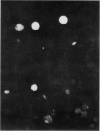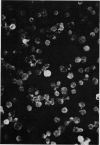Abstract
The relative value of heterophil agglutinins (HA) and of specific EBV antibodies in the diagnosis of infectious mononucleosis (IM) was assessed in 108 cases of the disease and in 280 controls. Among the 108 cases 93 were HA-positive by sheep cells in at least one of their sera, while 15 were HA-negative by the same test. Among the 280 controls false-positive HA tests were not encountered except in eight cases with the horse cell microtitre tests. With one of the two slide tests at least two false-positive tests and 12 false-negative tests were also found but these sera had low titres in microtitre tests. The HA life-span was found to be unexpectedly long in a few cases, sheep cell HA lasting up to 8 to 10 months and horse cell HA up to 21 to 23 months.
Many false-positive tests may therefore not be true false-positives and may result from the persistence of HA following unrecognized mononucleosis months before. Virtually all cases of IM had (or developed) antibodies to Epstein-Barr virus, viral capsid antigen (EBV-VCA), whereas only half of the controls were EBV-VCA-positive. The comparative analysis of nonspecific and specific test results in mononucleosis allows the following conclusions: (1) horse cell microtitre tests and the monospot test are more sensitive than sheep cell microtitre tests and the monotest; (2) false-negative results are occasionally seen with the latter tests but not with the former; (3) more false-positive results, however, are probably seen with the former tests; and (4) specific EBV-IgM and EBV-EA antibody tests are useful in the diagnosis of selected borderline cases of mononucleosis.
Full text
PDF





Images in this article
Selected References
These references are in PubMed. This may not be the complete list of references from this article.
- Banatvala J. E., Best J. M., Waller D. K. Epstein-Barr virus-specific IgM in infectious mononucleosis, Burkitt lymphoma, nasopharyngeal carcinoma. Lancet. 1972 Jun 3;1(7762):1205–1208. doi: 10.1016/s0140-6736(72)90925-7. [DOI] [PubMed] [Google Scholar]
- DAVIDSOHN I., LEE C. L. The laboratory in the diagnosis of infectious mononucleosis, with additional notes on epidemiology, etiology and pathogenesis. Med Clin North Am. 1962 Jan;46:225–244. doi: 10.1016/s0025-7125(16)33758-0. [DOI] [PubMed] [Google Scholar]
- Epstein M. A., Achong B. G. Observations on the nature of the herpes-type EB virus in cultured Burkitt lymphoblasts, using a specific immunofluorescence test. J Natl Cancer Inst. 1968 Mar;40(3):609–621. [PubMed] [Google Scholar]
- Evans A. S., Niederman J. C., McCollum R. W. Seroepidemiologic studies of infectious mononucleosis with EB virus. N Engl J Med. 1968 Nov 21;279(21):1121–1127. doi: 10.1056/NEJM196811212792101. [DOI] [PubMed] [Google Scholar]
- Gerber P. Activation of Epstein-Barr virus by 5-bromodeoxyuridine in "virus-free" human cells (complement-fixing antigen-immunofluorescence-leukocytes). Proc Natl Acad Sci U S A. 1972 Jan;69(1):83–85. doi: 10.1073/pnas.69.1.83. [DOI] [PMC free article] [PubMed] [Google Scholar]
- Hanshaw J. B., Niederman J. C., Chessin L. N. Cytomegalovirus macroglobulin in cell-associated herpesvirus infections. J Infect Dis. 1972 Mar;125(3):304–306. doi: 10.1093/infdis/125.3.304. [DOI] [PubMed] [Google Scholar]
- Henle G., Henle W. Immunofluorescence in cells derived from Burkitt's lymphoma. J Bacteriol. 1966 Mar;91(3):1248–1256. doi: 10.1128/jb.91.3.1248-1256.1966. [DOI] [PMC free article] [PubMed] [Google Scholar]
- Henle G., Henle W., Klein G. Demonstration of two distinct components in the early antigen complex of Epstein-Barr virus-infected cells. Int J Cancer. 1971 Sep 15;8(2):272–282. doi: 10.1002/ijc.2910080212. [DOI] [PubMed] [Google Scholar]
- Henle W., Henle G., Niederman J. C., Klemola E., Haltia K. Antibodies to early antigens induced by Epstein-Barr virus in infectious mononucleosis. J Infect Dis. 1971 Jul;124(1):58–67. doi: 10.1093/infdis/124.1.58. [DOI] [PubMed] [Google Scholar]
- Joncas J. H. Clinical significance of the EB herpesvirus infection in man. Prog Med Virol. 1972;14:200–240. [PubMed] [Google Scholar]
- Joncas J., Boucher J., Boudreault A., Granger-Julien M. Effect of hydrocortisone on cell viability, Epstein-Barr virus genome expression, and interferon synthesis in human lymphoblastoid cell lines. Cancer Res. 1973 Sep;33(9):2142–2148. [PubMed] [Google Scholar]
- Joncas J., Mitnyan C. Serological response of the EBV antibodies in pediatric cases of infectious mononucleosis and in their contacts. Can Med Assoc J. 1970 Jun 6;102(12):1260–1263. [PMC free article] [PubMed] [Google Scholar]
- Jordan M. C., Rousseau W., Stewart J. A., Noble G. R., Chin T. D. Spontaneous cytomegalovirus mononucleosis. Clinical and laboratory observations in nine cases. Ann Intern Med. 1973 Aug;79(2):153–160. doi: 10.7326/0003-4819-79-2-153. [DOI] [PubMed] [Google Scholar]
- Klemola E., Käriäinen L. Cytomegalovirus as a possible cause of a disease resembling infectious mononucleosis. Br Med J. 1965 Nov 6;2(5470):1099–1102. doi: 10.1136/bmj.2.5470.1099. [DOI] [PMC free article] [PubMed] [Google Scholar]
- Klemola E., Käriäinen L., von Essen R., Haltia K., Koivuniemi A., von Bonsdorff C. H. Further studies on cytomegalovirus mononucleosis in previously healthy individuals. Acta Med Scand. 1967 Sep;182(3):311–322. doi: 10.1111/j.0954-6820.1967.tb11529.x. [DOI] [PubMed] [Google Scholar]
- Klemola E., von Essen R., Wager O., Haltia K., Koivuniemi A., Salmi I. Cytomegalovirus mononucleosis in previously healthy individuals. Five new cases and follow-up of 13 previously published cases. Ann Intern Med. 1969 Jul;71(1):11–19. doi: 10.7326/0003-4819-71-1-11. [DOI] [PubMed] [Google Scholar]
- Lee C. L., Zandrew F., Davidsohn I. Horse agglutinins in infectious mononueleosis. 3. riterion for differential diagnosis. J Clin Pathol. 1968 Sep;21(5):631–634. doi: 10.1136/jcp.21.5.631. [DOI] [PMC free article] [PubMed] [Google Scholar]
- Niederman J. C., McCollum R. W., Henle G., Henle W. Infectious mononucleosis. Clinical manifestations in relation to EB virus antibodies. JAMA. 1968 Jan 15;203(3):205–209. doi: 10.1001/jama.203.3.205. [DOI] [PubMed] [Google Scholar]
- Ogra P. L., Kerr-Grant D., Umana G., Dzierba J., Weintraub D. Antibody response in serum and nasopharynx after naturally acquired and vaccine-induced infection with rubella virus. N Engl J Med. 1971 Dec 9;285(24):1333–1339. doi: 10.1056/NEJM197112092852401. [DOI] [PubMed] [Google Scholar]
- Pope J. H., Horne M. K., Wetters E. J. Significance of a complement-fixing antigen associated with herpes-like virus and detected in the Raji cell line. Nature. 1969 Apr 12;222(5189):186–187. doi: 10.1038/222186a0. [DOI] [PubMed] [Google Scholar]
- Reedman B. M., Klein G. Cellular localization of an Epstein-Barr virus (EBV)-associated complement-fixing antigen in producer and non-producer lymphoblastoid cell lines. Int J Cancer. 1973 May;11(3):499–520. doi: 10.1002/ijc.2910110302. [DOI] [PubMed] [Google Scholar]
- Schmitz H., Scherer M. IgM antibodies to Epstein-Barr virus in infectious mononucleosis. Arch Gesamte Virusforsch. 1972;37(4):332–339. doi: 10.1007/BF01241456. [DOI] [PubMed] [Google Scholar]
- Strannegård O., Holm S. E., Hermodsson S., Norrby R., Lycke E. Case of apparent reinfection with rubella. Lancet. 1970 Jan 31;1(7640):240–241. doi: 10.1016/s0140-6736(70)90595-7. [DOI] [PubMed] [Google Scholar]
- Vonka V., Benyesh-Melnick M., McCombs R. M. Antibodies in human sera to soluble and viral antigens found in Burkitt lymphoma and other lymphoblastoid cell lines. J Natl Cancer Inst. 1970 Apr;44(4):865–872. [PubMed] [Google Scholar]





